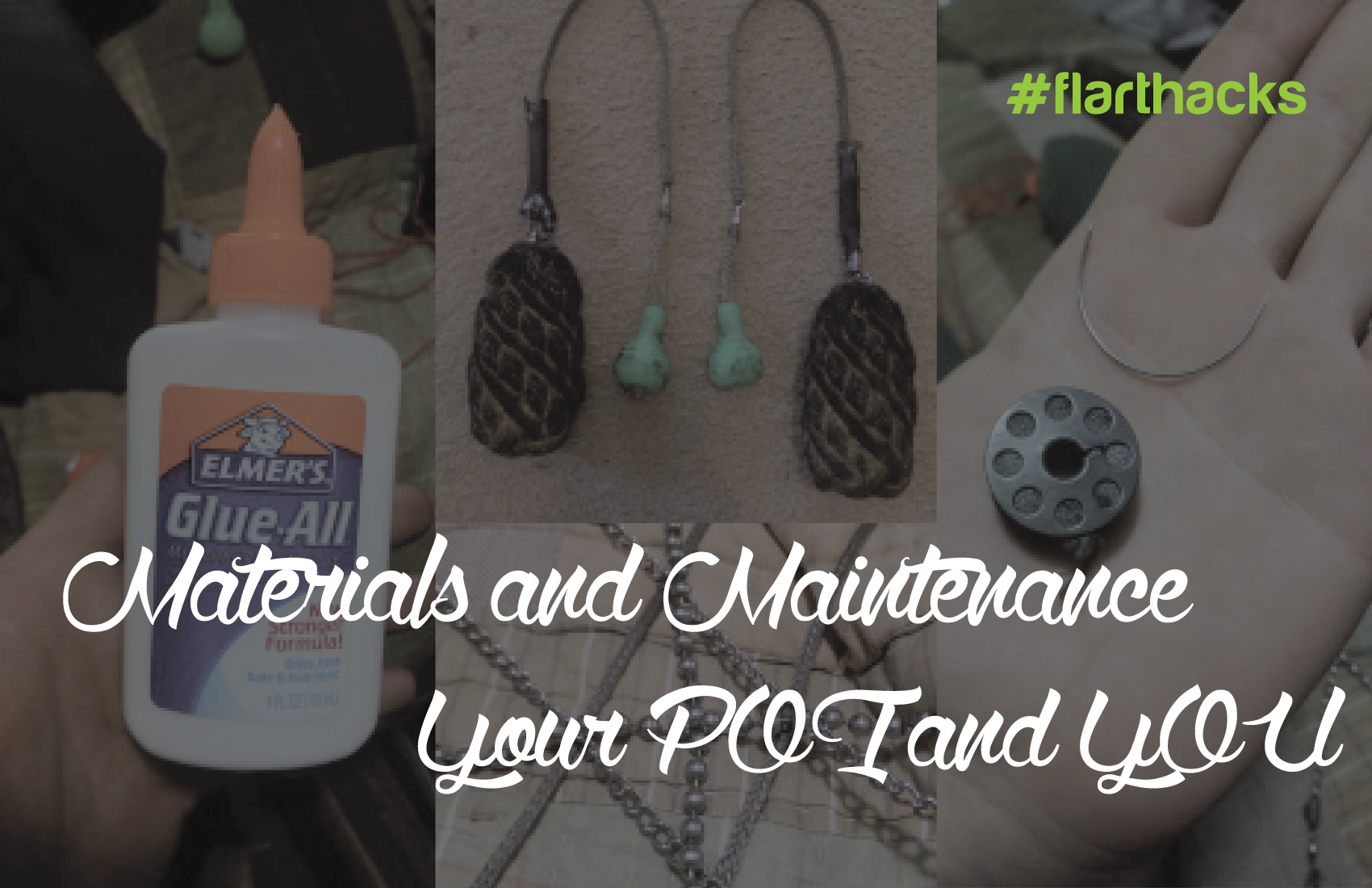Let’s talk poi, folks. It seems to be the most popular prop lately, and the flow arts community is starting to grow faster than proper information can spread. In the interest of helping you find your flow and make it last, here is some useful information for picking your first set of poi, and some tips and tricks to get as much out of them as possible.
Index:
Wicks
– Barrel – Probably the most common type of wick, a barrel knot consists of kevlar tape, usually 3-5 inches in width, rolled around a chain (or, more commonly, staff), and held together with screws, rivets, or kevlar thread. Barrels are inexpensive and extremely easy to make and modestly durable, with a modest flame size and duration.
– Monkey Fist – Probably the most common wick for poi, the monkey’s fist is constructed of a core (usually wooden) with kevlar rope encircling in 3 stages to fully cover the core. Monkey Fist knots are highly durable, and their easy stalls and aerodynamic shape lend well to fast and teach heavy spinning styles. They have an average flame size and an above average burn duration
– Cathedral – Cathedrals are easy to make, and easy to spin, making them great for beginners. They are constructed from one or two strips of kevlar tape, acordioned over itself, with (usually) a bolt core holding them together. This design utilizes more surface area than a barrel, creating a larger flame, longer burn, and slower spin. This works well with a slower, dance-oriented style of spinning, or a beginner looking for a little bit more time to figure out their moves.
– Snakes – Snakes are fun and snakes are scary. Designs vary from maker to maker, but fire snakes generally feature a 12-24″ kevlar rope (or several braided together) with a weighted end, the entire length of which burns. Snakes are not for the faint of heart, and should be approached with caution whether you are new or a veteran burner, but lord are they fun!
– Novas – While the prior wicks are all standard and available from most makers, I wanted to specifically note Nova wicks while I’m at it. The Novas by Dark Monk are, in my humble opinion, the best poi wick currently available. This clever knot produces an a long burn time, impressive flame size, and a phenomenal spinning experience due to the impeccable weight distribution.
Leashes
– Ball Chain – Ball chain is the most common “first poi” chain, due to several factors: it is cheap, it doesn’t require swivels, it is easy to cut to length and attach. Everything about ball chain is easy. The big downside to ball chain is that you cannot assess any damage to your leashes until you have a catastrophic failure. That’s not saying that you WILL have one – take care of your equipment, replace the chain every 6-12 months, and you should be fine, but if any leash ever snaps and sends a fireball flying, it’s ball chain
 – Oval Link Chain – Preferably with welded links, oval link chain is the standard poi leash. Often sourced from pet stores (dog chains), oval link will require a swivel if you intend to do orbitals, but it is a durable and reliable alternative to ball link. With both chains you must be careful on wrap moves, as the heated chain can cause some impressive and immediate burns
– Oval Link Chain – Preferably with welded links, oval link chain is the standard poi leash. Often sourced from pet stores (dog chains), oval link will require a swivel if you intend to do orbitals, but it is a durable and reliable alternative to ball link. With both chains you must be careful on wrap moves, as the heated chain can cause some impressive and immediate burns
– Technora – Technora is a recent innovation in the poi world, and has some bugs still to be worked out, but they are aesthetic concerns, primarily. Technora is a high strength, high heat resistance aramid rope. Technora has a decomposition point of 932°F, so it should not be used alone to replace chain, but there are several alternatives that allow technora to be used safely such as sleeving the technora in a high-temperature resistant barrier (silicone tape/Dark Monk leash sleeving), or splicing the technora to a length of chain (3 inches should be sufficient, but again, watch out for heated metal on wraps!). Technora is rapidly becoming the new standard for poi, and is my personal preference
Handles
– Double Loops – Your standard pair of poi will come with a pair of these “bunny ear” style handles, typically worn on the index and middle finger for a solid, constant connection to your poi
– Single Loops – As the name implies, these are a standard single loop of fabric or leather that can be held, wrapped around the fingers, or used to catch at the knuckles for a secure grip
– Knob Handles – A must if you intend to juggle poi, or incorporate tosses into your spinning, knob handles open up a variety of new poi moves and exciting toss-and-catch play, at the risk of losing grip when your hands sweat, and having bulky knobs to deal with when performing wraps. I prefer knobs, myself, as I enjoy tossing my poi
Protective Measures
So you’ve got your poi? Great! Here are some tips to help them stay around longer:
– Spin them out – Letting your wicks burn out is very, very bad for the kevlar, as you will no longer be burning just fuel, but your kevlar, too! Once you see your wicks starting to sputter, it’s time to kick up the speed, or grab a safety duvetyne, but get that flame out before it can eat your wicks!
– Work the corner – On wicks that have ridges (cathedrals, Dark Monk Cherry Bombs, etc) run a bead of PVA glue (standard, white Elmer’s) down the edge – The wick’s flame will harden this and give your wick a bit of added protection and durability in areas where repeated impacts will start to cause damage. This dries clear and doesn’t cause a noticeable decrease in flame size
 – Prophylactics – As I mentioned earlier, Technora has a degradation point of 932°F. That’s high, but not high enough to have flames eating at it without some form of protection. Dark Monk offers an
– Prophylactics – As I mentioned earlier, Technora has a degradation point of 932°F. That’s high, but not high enough to have flames eating at it without some form of protection. Dark Monk offers an  exceptional Leash Sleeving that can be slid over quicklinks, chains, and technora to keep you from getting metal burns, and your technora from degrading. You can also use self-amalgamating silicone tape from your local hardware store – it doesn’t look as pretty, but it still keeps you from burning!
exceptional Leash Sleeving that can be slid over quicklinks, chains, and technora to keep you from getting metal burns, and your technora from degrading. You can also use self-amalgamating silicone tape from your local hardware store – it doesn’t look as pretty, but it still keeps you from burning!
– Mind your hardware – It’s important that you pick quicklinks with high weight limits, swivels made for abuse that won’t die or grind, and chains that are welded for abuse. You’re playing with fire, often with an audience! Be mindful of yourself and your gear, which brings us to…
Standard Maintenance
Remember to show your props love. They need TLC now and then to keep giving you fun, safe burns!
– Wash your hand(le)s – Especially if you’re using knobs, you’ll get some soot on your handles sooner or later. Soot is greasy and can cause your poi to go flying at the most inopportune moments. A little dish soap and warm water is all it takes!
 From soot stained and nasty to nice and grippy
From soot stained and nasty to nice and grippy
– Check your gear – If you’ve got ball chain, look for dented balls. If you find them, replace your chain, you don’t wan that splitting mid spin! Make sure your technora is properly protected from the flames, whether by a length of chain or sleeving. Make sure the sleeving is still in good order, it does need occasional replacement.
– For God’s sake, COVER YOUR FUEL. This is just general purpose – Never light up with fuel containers uncovered or open
Repair
It’s inevitable – Over time and with burning your wicks will degrade, your props will break. Fear not, there are some simple supplies you can pick up to help increase the lifespan of your props, and bring them back from death’s door.
 – PVA Glue – A standard bottle of Elmer’s White Glue. If your barrel wicks unroll, or a cathedral starts to separate, keep the glue as internal as possible (since glue on the outside surface of the wick reduces flame size), but white glue will only get harder from the heat, and will help you keep your wick alive.
– PVA Glue – A standard bottle of Elmer’s White Glue. If your barrel wicks unroll, or a cathedral starts to separate, keep the glue as internal as possible (since glue on the outside surface of the wick reduces flame size), but white glue will only get harder from the heat, and will help you keep your wick alive.
– Kevlar Thread – Better still than the glue is kevlar thread and a  stainless steel suture needle. The parabolic shape of the needle will allow you to maneuver around a wick’s folds and securely stitch the ropes or strips of kevlar on your prop back into place. Kevlar thread will be able to handle the same heat as the kevlar wicks, and hold your prop together after too many meetings with the ground.
stainless steel suture needle. The parabolic shape of the needle will allow you to maneuver around a wick’s folds and securely stitch the ropes or strips of kevlar on your prop back into place. Kevlar thread will be able to handle the same heat as the kevlar wicks, and hold your prop together after too many meetings with the ground.
Hopefully this helps you get into your first set of fire poi with more confidence, and helps you keep them alive for many years of fun burns. Spin well and, as always, spin safe! Knowledge is power!


